16-04-2024 - Economy - Monopolistic competition [EN]-[IT]
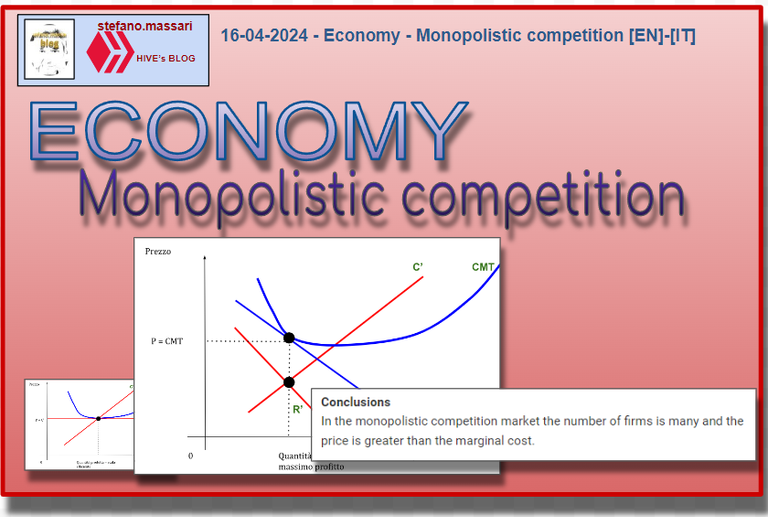
~~~ La versione in italiano inizia subito dopo la versione in inglese ~~~
ENGLISH
16-04-2024 - Economy - Monopolistic competition [EN]-[IT]
Monopolistic Competition
Description
Even if it seems strange, monopolistic competition or something we can define as such also exists.
This competition is defined by the following aspects:
-Many sellers
-Minimal product differentiation
-Freedom of entry
Basically, monopolistic competition is a form of market characterized by the presence of a considerable number of companies, which can exercise their influence on the market through product differentiation, always considering that these differentiations will in any case be minimal.
Since this is also a market open to other companies, there is the threat of entry of other and new companies. Existing businesses will try to limit the profit they can generate based on the price they can decide. From this we can state that a perfectly contestable market is one where there are no barriers to exit and entry and there are no sunk costs. In this case, companies will tend to define the price on the basis of: limit price, predatory prices (thanks to economies of scale), excess production capacity and aggressive marketing strategies. As we have said, anyone can enter this market but all this should generate barriers to entry, discourage the entry of other companies and finally generate competitive advantage.
Examples
Below are some examples of these markets, i.e. examples of monopolistic competition.
Video games, Restaurants, Organization of conferences, Coach rental, Funeral services, Pest control, Waste disposal, Driving schools.
Short period
In the short term, in a market of monopolistic competition, each firm behaves as a monopolist and therefore faces decreasing demand and tries to maximize its profit. In the short term he will be able to regulate himself and understand how to produce the quantity that will allow him to have a marginal cost equal to marginal revenue.
Long period
As we said before, there are no barriers to the entry of new businesses, let's take this into consideration. Consequently, in the long run those who are making losses will exit the market while if there are profits, new firms will enter the market.
In the case of the entry of new companies, the supply of products in the market will increase, reducing the demand for each company already present in the market.
The process of adjustment, or search for the new structure, both in the case of a losing market and in the case of a profitable market, will bring the price to equal the Average Total Cost, i.e. P=CMT and in this condition the profit is zero.
Graphic
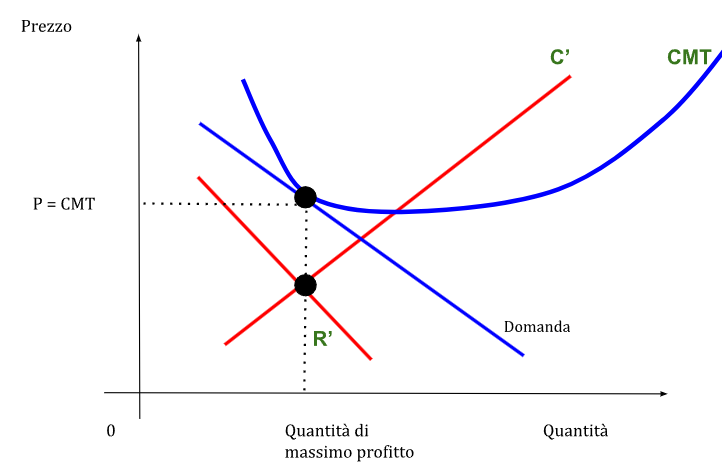
From the graph we note that the Average Total Cost (CMT) is tangent to the demand curve and the equilibrium point is the tangency point.
Average total cost is greater than marginal cost (CMT>C')
Where the marginal cost is equal to the marginal revenue, the price is defined, in free competition market conditions.
Summary with graphs
Firm under perfect competition
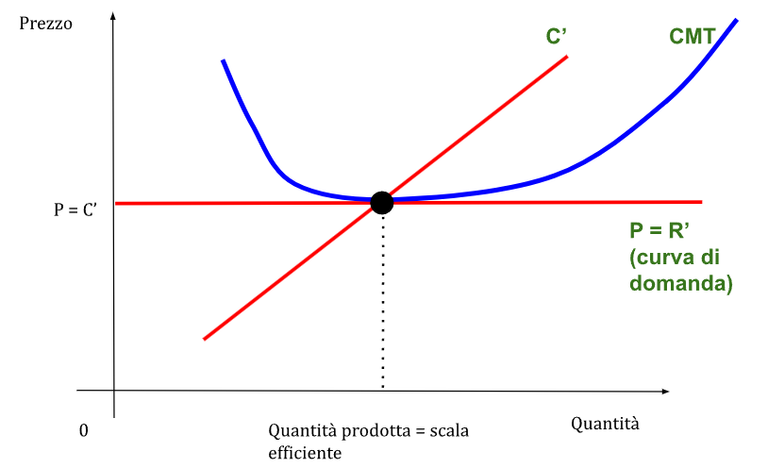
Company under monopolistic competition
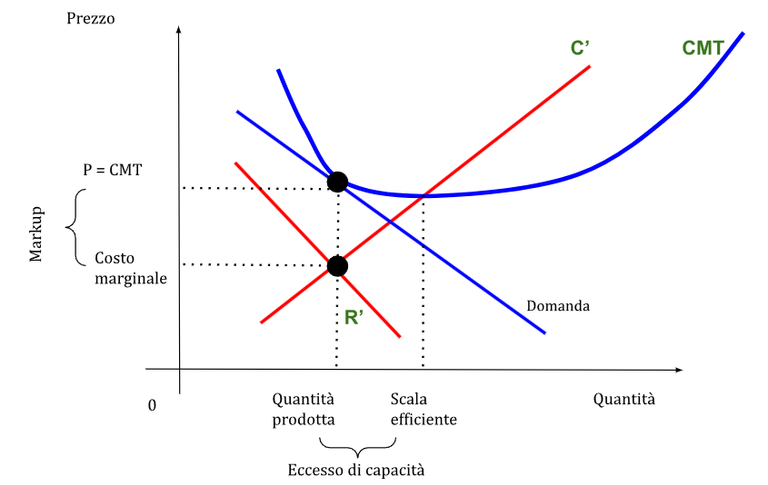
Conclusions
In the monopolistic competition market the number of firms is many and the price is greater than the marginal cost.
Request
Have you ever worked in a company that operated in a monopolistic competition market, such as waste disposal or pest control?

ITALIAN
16-04-2024 - Economia - Concorrenza monopolistica [EN]-[IT]
Concorrenza monopolistica
Descrizione
Anche se sembra strano, esiste anche la concorrenza monopolistica o qualcosa che possiamo definire tale.
Tale concorrenza è definita dai seguenti aspetti:
-Molti venditori
-Differenziazione del prodotto minimale
-Libertà di entrata
Sostanzialmente la concorrenza monopolistica è una forma di mercato caratterizzata dalla presenza di un numero considerevole di imprese, le quali possono esercitare la propria influenza sul mercato attraverso la differenziazione del prodotto, sempre considerando che queste differenziazioni saranno comunque minime.
Essendo anche questo un mercato aperto ad altre imprese vi è la minaccia di ingresso di altre e nuove imprese. Le imprese già esistenti cercheranno di limitare il profitto che possono generare sulla base del prezzo che possono essi decidere. Da questo possiamo affermare che un mercato perfettamente contendibile è dove non vi sono barriere all’uscita e all’entrata e non vi sono costi sommersi. In questo caso le imprese tenderanno a definire il prezzo sulla base di: prezzo limite, prezzi predatori (grazie alle economie di scala), capacità produttiva in eccesso ed aggressive strategie di marketing. Come abbiamo detto chiunque può entrare in questo mercato ma tutto ciò dovrebbe generare delle barriere all’ingresso, disincentivare l’ingresso di altre imprese ed infine generare vantaggio competitivo.
Esempi
Qui di seguito alcuni esempi di questi mercati, cioè esempi di concorrenza monopolistica.
Videogiochi, Ristoranti, Organizzazione di conferenze, Noleggio di pullman, Pompe funebri, Disinfestazioni, Smaltimento rifiuti, Scuole guida.
Breve periodo
Nel breve periodo, in un mercato di concorrenza monopolistica, ogni impresa si comporta da monopolista e quindi si confronta con una domanda decrescente e cerca di massimizzare il proprio profitto. Nel breve periodo riuscirà a regolarsi ed a capire di produrre la quantità che gli permetterà di avere un costo marginale pari al ricavo marginale.
Lungo periodo
Come abbiamo detto prima, non ci sono sbarramenti all’ingresso di nuove imprese, teniamo in considerazione questo. Di conseguenza, nel lungo periodo coloro che stanno subendo delle perdite usciranno dal mercato mentre se vi sono dei profitti, nuove imprese entreranno nel mercato.
Nel caso dell’ingresso di nuove imprese, aumenterà l’offerta di prodotti nel mercato, riducendo la domanda per ciascuna impresa già presente nel mercato.
Il processo di aggiustamento, o di ricerca del nuovo assetto, sia in caso di mercato in perdita sia in caso di mercato con profitti, porterà il prezzo ad eguagliare il Costo Medio Totale, cioè P=CMT ed in questa condizione il profitto è nullo.
Grafico

Dal grafico notiamo che il Costo Medio Totale (CMT) è tangente alla curva di domanda ed il punto di equilibrio è il punto di tangenza.
Il costo medio totale è maggior del costo marginale (CMT>C’)
Dove il costo marginale è uguale al ricavo marginale è definito il prezzo, in condizione di mercato di libera concorrenza.
Riassunto con grafici
Impresa in regime di concorrenza perfetta

Impresa in regime di concorrenza monopolistica

Conclusioni
Nel mercato di concorrenza monopolistica il numero di imprese sono molte il prezzo è maggiore del costo marginale.
Domanda
Avete mai lavorato in un'azienda che operava in un mercato di concorrenza monopolistica, tipo smaltimento rifiuti o settore disinfestazione?
THE END
👏 Keep Up the good work on Hive ♦️ 👏
❤️ @reeta0119 suggested sagarkothari88 to upvote your post ❤️
🙏 Don't forget to Support Back 🙏
Thanks for the support, with these types of technical contents I lost a few comments. Your support helps me continue
@stefano.massari, you are most welcome!
Please Support Back
!ALIVE token gift for you
@stefano.massari! You Are Alive so I just staked 0.1 $ALIVE to your account on behalf of @ hivecurators. (3/10)
The tip has been paid for by the We Are Alive Tribe through the earnings on @alive.chat, feel free to swing by our daily chat any time you want, plus you can win Hive Power (2x 50 HP) and Alive Power (2x 500 AP) delegations (4 weeks), and Ecency Points (4x 50 EP), in our chat every day.

If a market has many sellers, most of every seller will love to sell what is in demand. That’s where the problem lies so a product needs to be very good so it can always be on top of the competition
that's exactly the point. When the market is saturated, quality is important, otherwise low-quality products will remain unsold
However, even in the market of monopolistic competition, not to be confused with the monopolistic market, those who suffer losses in the long term will exit the market, while if there are profits other companies will try to enter this market
When there is monopoly, there will be high cost irrespective of the numerous companies involved
Thanks for stopping by. If we try to study the monopolistic competition market (which has some differences with the monopolistic market), we can say that over time the price will equal the average total cost. It will probably be lower at the beginning and there could be substantial profits, but then P = CMT (price equal to average total cost). If we draw a graph, the price and the average cost will be found where the total average cost curve is tangent to the demand line
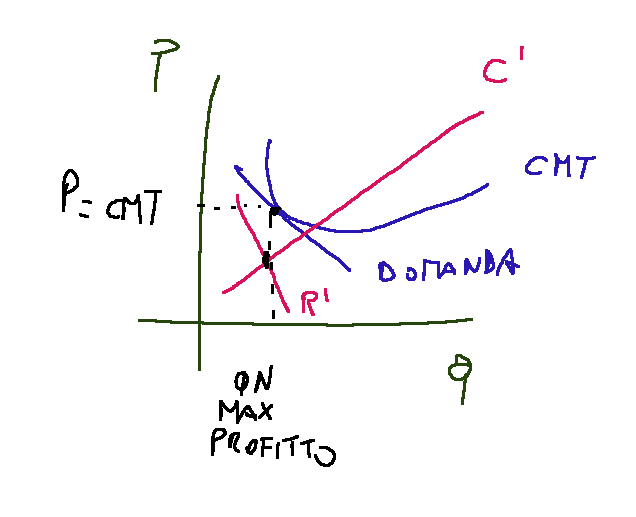
Non ho mai lavorato in questo tipo di aziende, in alcune che gestiscono il monopolio sì
Grazie per aver lasciato una risposta. In un elenco di esempi di concorrenza monopolistica ho trovato anche l'attività di noleggio pullman, sartoria e insegnati di musica... sai che ad un certo punto ho pensato anche di provare a fare l'insegnante di musica?! Ma non l'ho mai fatto.